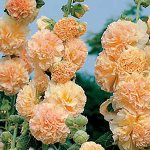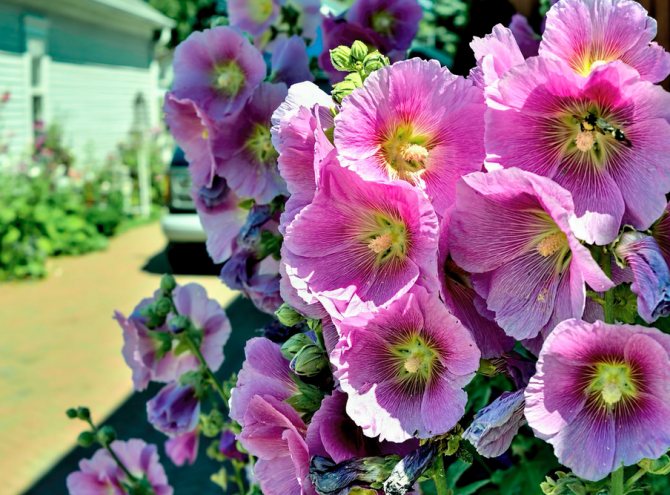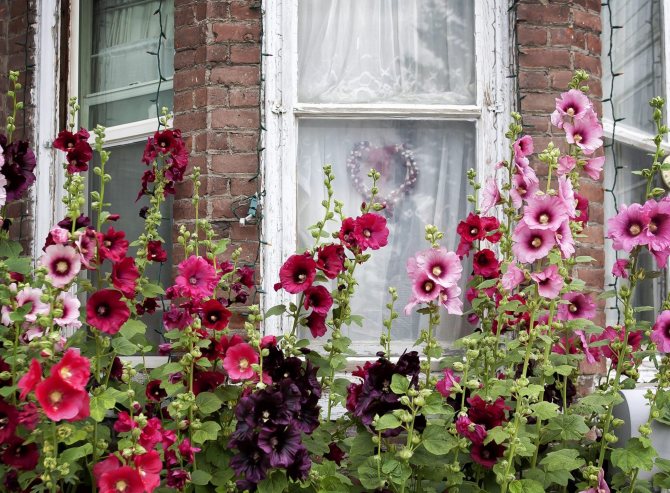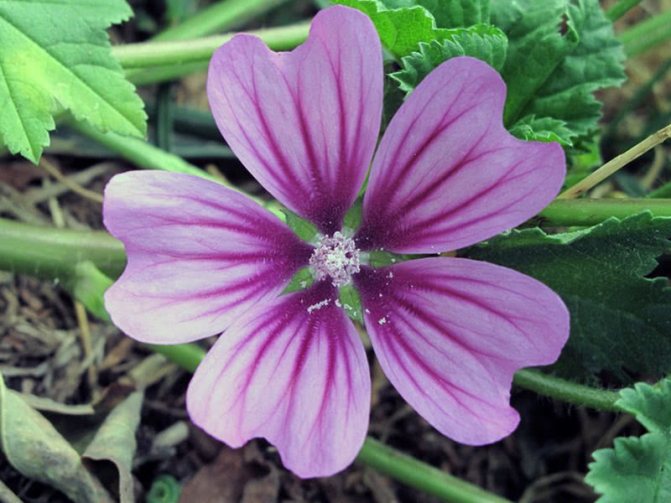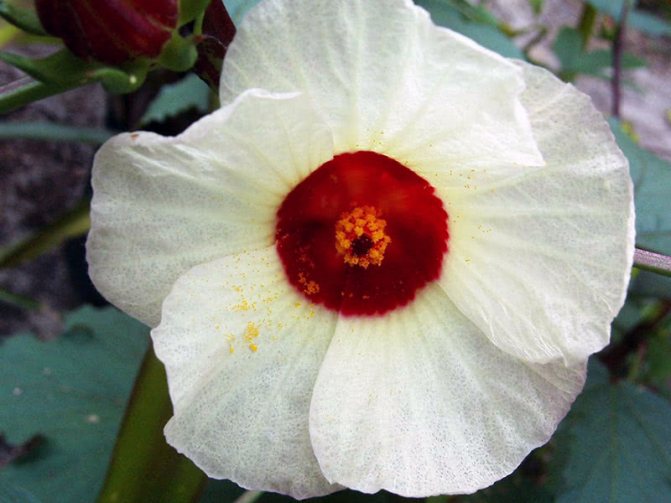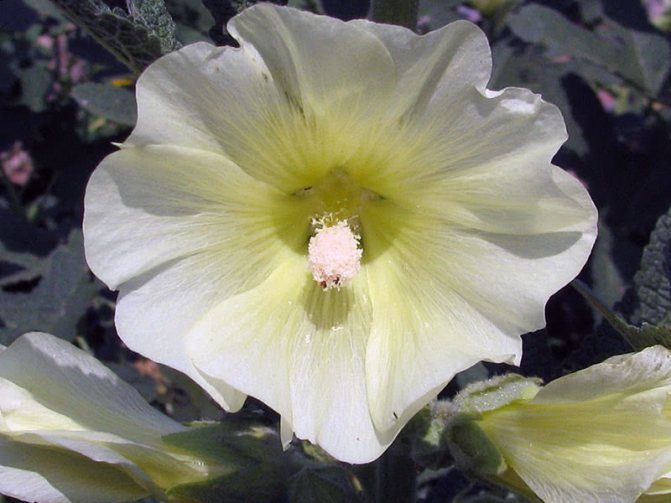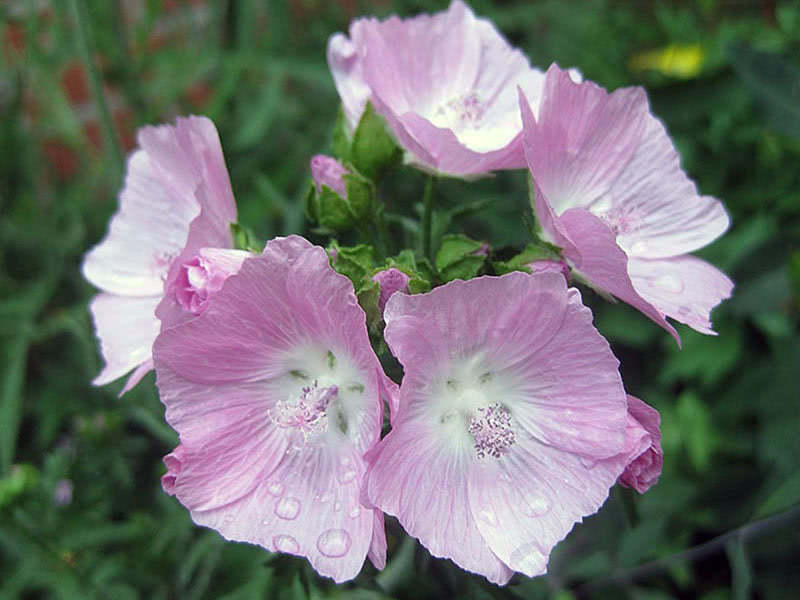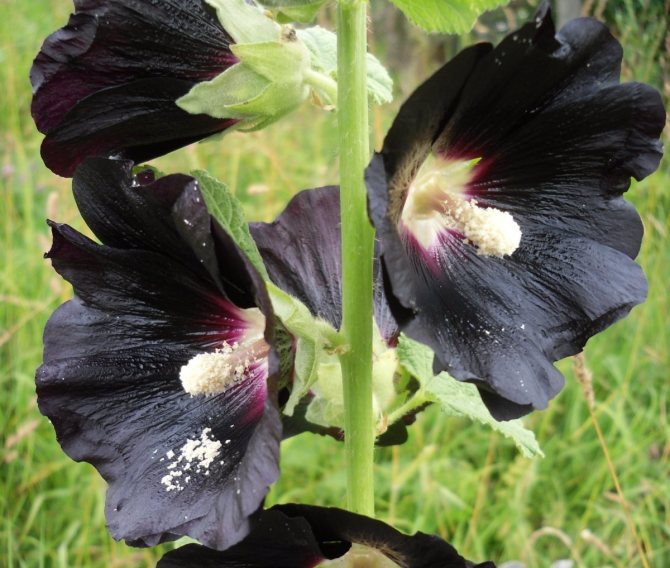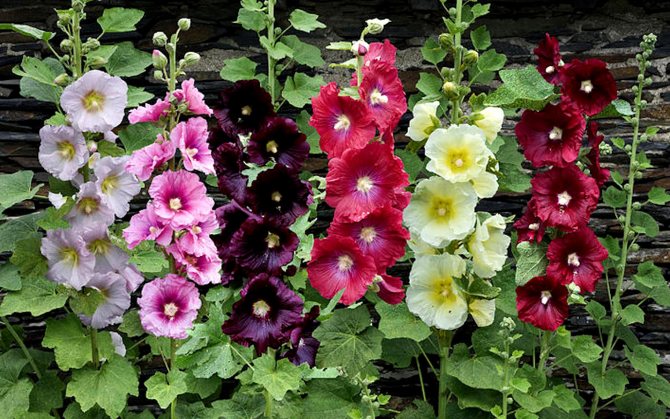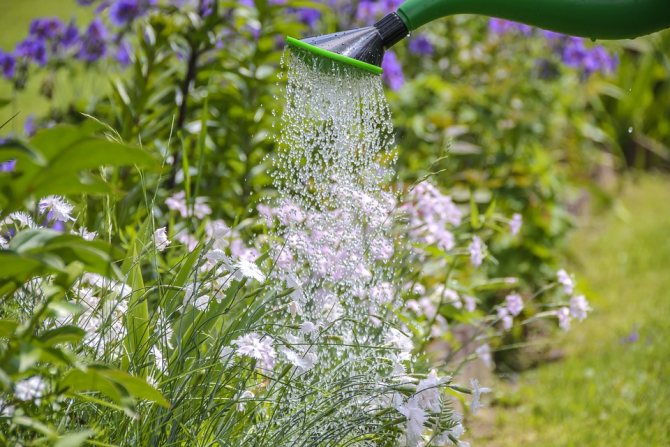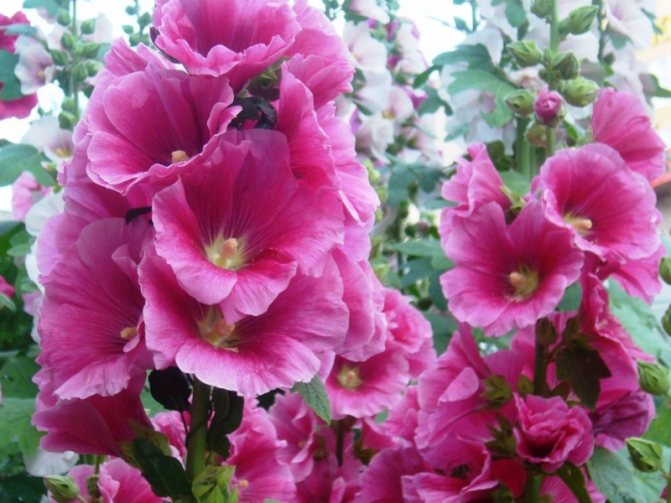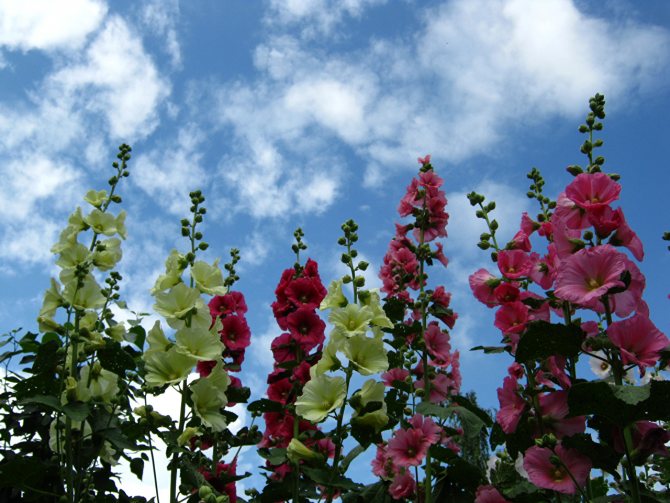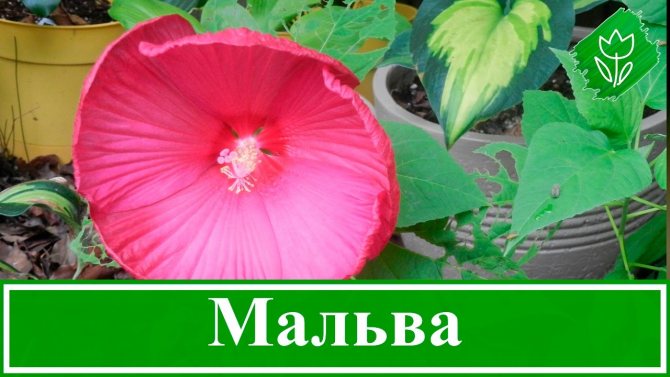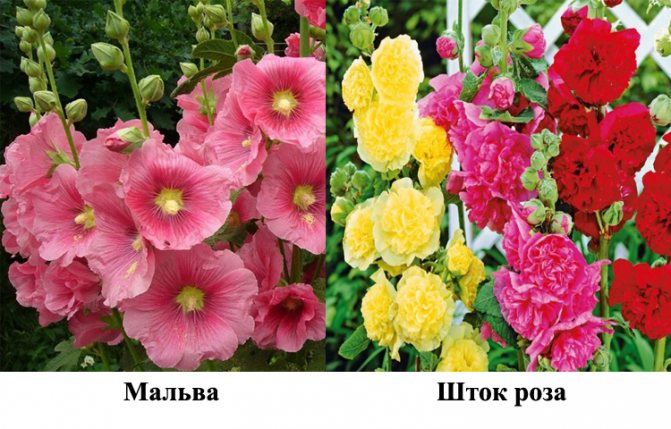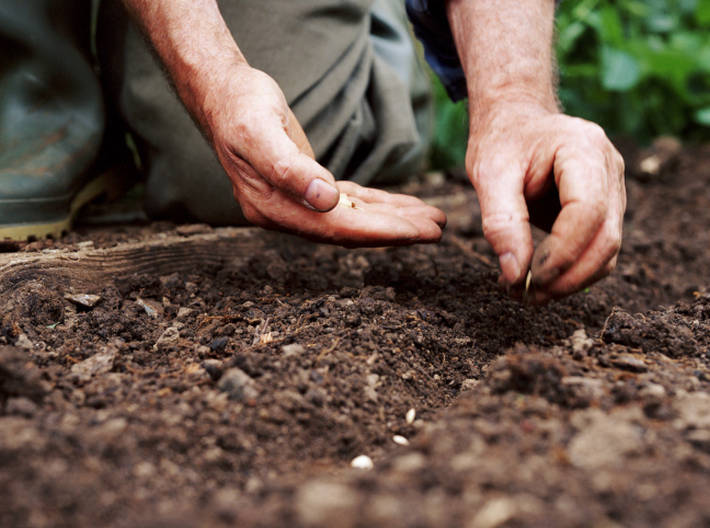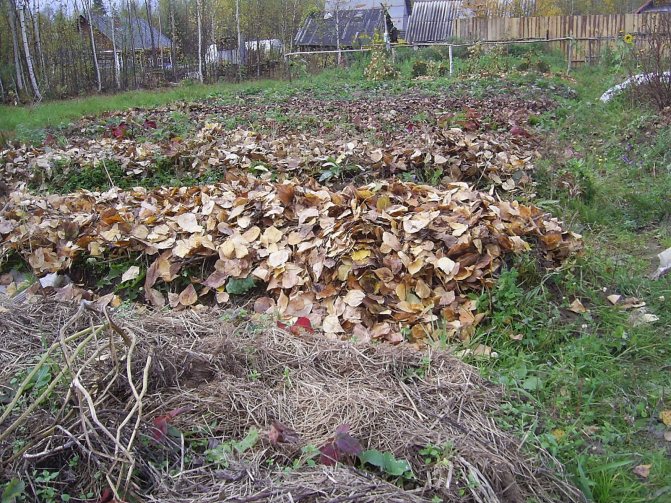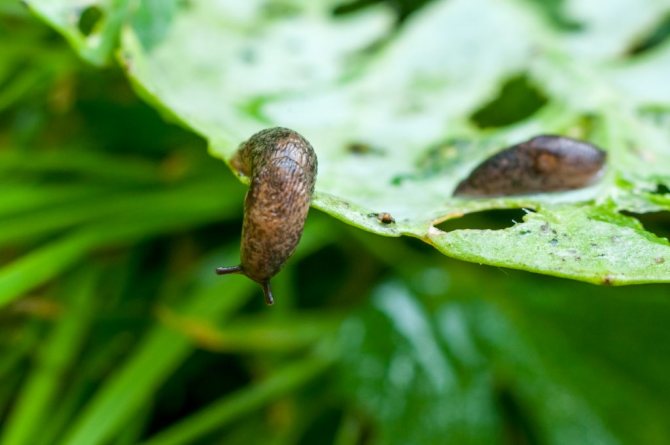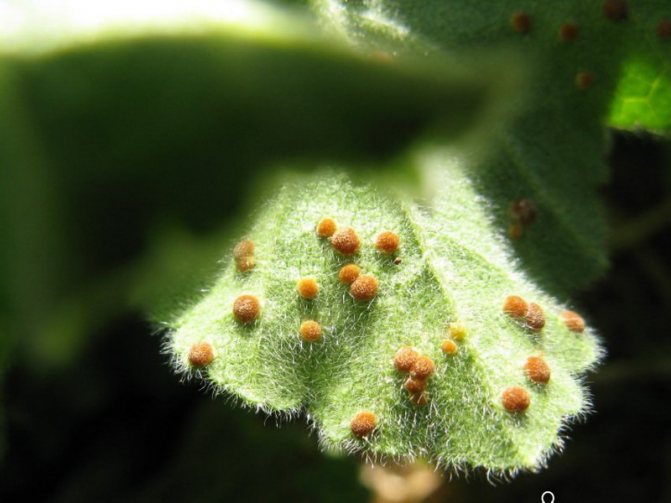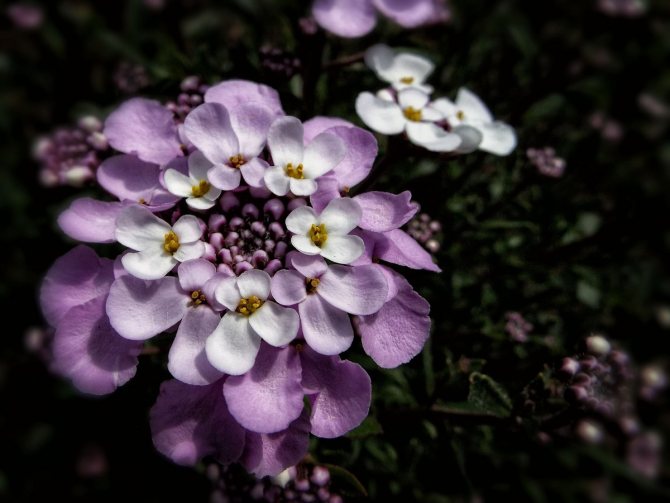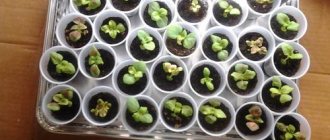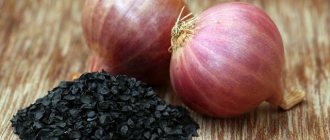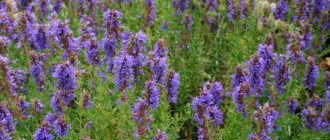When selecting perennials for a flower bed, remember about mallow. Growing a beautiful and spectacular plant will decorate any front garden. Both experienced and novice growers like mallow for perennial planting with seeds. A perennial flower with a long history looks great in the garden decor of small summer cottages and luxury cottages. The plant represents sun and summer, charm and luxury, peace and restraint. Some summer residents are interested in how they plant mallow seeds in open ground.
Description, types and photos of mallow
A flower that grows in natural conditions can have height from 30 to 110 cm
... The plant is distinguished by heart-shaped leaves and large flowers up to 13 cm in diameter. The color of the oblong petals depends on the species and variety. They can be white, pink, lilac, burgundy and even almost black.
Popular varieties
All types and varieties of mallow are divided into annuals and perennials.
Annual mallow is a biennial plant but is grown as an annual. It grows up to 1.2 m and is distinguished by dark stripes on flower petals. Among the most famous varieties
can be distinguished:
Perennial mallow
very loved by gardeners. Among the whole variety of its varieties, the following can be distinguished:
- Wrinkled mallow in garden plots reaches a height of no more than 90 cm, although in nature it can grow up to one and a half meters and more. The plant is decorated with yellow flowers with a diameter of up to 3 cm.
- Sudanese mallow has medicinal properties and is grown mainly for the sake of the fruit. The shrub and tree-like form of the plant is known.
- Mallows "Pink Tower" and "White Tower" grow up to 70 cm. They bloom for a long time almost until frost.
- Musk or nutmeg mallow reaches a height of 1 m. Its very fragrant white and pink flowers have a diameter of 30-50 mm.
Hybrid mallows are also perennial crops. They are differ in height up to 180 cm
, large stems and flowers of a pale pink or white shade. Flowering lasts from early summer to the coldest autumn.
Description of the plant
Mallows are native to Central and Western Asia, and are found in the wild in the Balkans and southern Russia. In culture, numerous varieties and hybrids are grown, obtained by crossing wild species.
Their height ranges from a very small Majorette Mixed, not growing higher than 80 cm, to a giant Powder Puffs Mixed, which is 2 m high. All mallows have erect stems, at first pubescent, and then bare, one bush can give up to 15 shoots. Mallow is also characterized by large alternate leaves with long petioles, also pubescent. Their shape is varied and can be rounded heart-shaped or have up to 7 lobes. In the axils of the leaves, flowers are formed in number from 1 to 5. They have an accrete base and a split top. The diameter of the flower ranges from 5 to 15 cm. There are many interesting forms with double flowers. The color palette of mallow is very diverse and includes almost all colors and shades. Flowers are usually collected in a brush, there can be up to 150 of them.
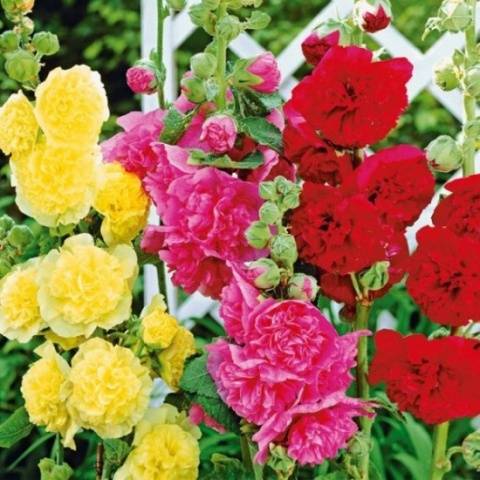
For the most part, mallows are perennials or biennials. There are much fewer annual plants among them.
Important! Mallow is a medicinal plant used in folk medicine as an expectorant.
Perennial mallow: planting and care
In one place, a plant can grow without any transplants for a long time, so the site must immediately meet all the conditions for growing a flower.
Mallows love well-lit places, protected from direct sunlight and strong winds. The best soil for them is light loam. It must be well-drained and nutritious.
Mallow seeds for seedlings are sown at home in April or early May. Sowing in open ground is carried out at the end of June. Home-grown seedlings per plot landed only at the end of August
.
Mallow does not require special care. It is enough to water them on time and regularly and sometimes to feed them. In warm weather, watering is done once a week, and on hot days, the bushes are watered abundantly. The stock-rose does not like stagnation of water in the soil, therefore, waterlogging of the soil should not be allowed.
Once every 15-20 days, mallows are fed with a weak solution of phosphorus-potassium fertilizers. For additional aeration, the soil is periodically recommended to be cleaned of weeds and loosened. This must be done very carefully so as not to damage the delicate root system of the stem-rose.
To prevent the wind from breaking tall bushes, they need to be tied to supports. Around the middle of summer, you can collect and prepare seeds from the plant. After flowering, the stalks of the mallow are cut off.
In the fall, caring for mallow consists in preparing the plant for wintering. For this use fallen leaves
, which covers the areas where stock-rose bushes grow.
The appearance of small red spots on the leaves may indicate that the plant has been damaged by rust. Mallows can also be prone to mosaic and powdery mildew. Therefore, it is not recommended to plant them for two years on areas previously infected with these diseases. When signs of one of these diseases appear, the affected leaves are cut off and burned, and the bushes must be treated with fungicidal preparations.
Sowing in open ground
In the first year, when sowing seeds in an open flower bed, the plant will grow a leaf rosette, unless, of course, it is an annual one. In this case, you will see flowers this season.
The thoughtfulness of the place plays a very important role. Mallow is considered a tall flower, so think about the need for support or support in advance. And also that the site is not in the wind, because in this case, an incident may happen - the wind will break the tall stems.
Read also: Jellied cranberry pie recipe with photo
Note! In stockrose, the root system is a long rod, so planting can be carried out without problems only when the plant is young.
In order for the mallow to feel comfortable and safe, it is best to choose a sunny place where the soil is fertile. However, even in shaded areas, mallow grows well, not being capricious. A long root shaft is able to break through the soil and obtain moisture for itself at a fairly large distance from the soil surface.
How to prepare the soil
Despite the fact that mallow belongs to those crops that do not require any special care, nevertheless, some rules regarding the soil should be followed, because the duration and brightness of flowering depends on this.
The area where the stockrose will grow should be as follows:
- Water should not accumulate on it, this is unacceptable for a plant.
- Loam will be the best option for planting, and if you add humus, humus and a small part of sand to it, the place will be just perfect.
- If the soil has a high sand content, then it should be mixed with peat, clay and rotted manure.
- Before planting seeds, you should dig up the ground and pick weeds out of it.
- After digging, it is necessary to fill the earth with ash and humus.
Here are the simple rules that must be followed before planting mallow seeds in open ground.
Preparation of planting material
From the experience of flower growers, we can conclude that mallow seeds should lie down for a while and, as it were, finish their ripening. Someone may object, because self-seeding occurs immediately after the seeds are ejected from the box, and nothing, mallow grows without problems. Yes, this is true, but some of the seeds die, and the lying specimens just sprout more amicably and faster. The fact is that during the holding time, the seed coat dries up and is not an obstacle for friendly seedlings.
Until the planting material gets into the soil, it must be soaked for half a day in warm water.
How to sow seeds correctly
It is not necessary to part with crops, the distance between the seeds should be at least 50-60 cm, however, for small species it can be much less. The holes are made 3 cm deep, having embedded seeds in them, a layer of earth is sprinkled on top and compacted. Moisture during this period is simply necessary for seedlings, so this area should be constantly moistened. For the effectiveness of piercing and moisture retention, the area from above should be covered with lutrasil.
From the moment of planting to emergence, it usually takes about three weeks.
How to choose a sowing date
There are two periods of sowing mallow - spring and autumn. Both those and other plants will bloom only next year. For spring planting, you should withstand the time and wait out the return frosts, and in the fall, sowing is carried out in September until stable frosts.
Note! In order for the seedlings to be guaranteed not to freeze in winter, the stem of the rose is mulched with peat or straw.
Mallow - growing from seeds
You can sow seeds directly into open ground or first grow seedlings from them at home.
Sowing seeds in open ground
You can sow seeds before winter or at the end of spring, when the last frosts have passed. To do this, in holes about 3 cm in size place two or three seeds at a time
... Seeds covered with earth and slightly rammed are well watered and covered with acrylic or polyethylene. In this case, the earth will not dry out, and the seeds will swell and sprout faster.
Perennial mallow flower is a very popular plant in summer cottages. I noticed that interest in mallow is undulating. That is, there are years when she is in favor with summer residents, and there are years when I see her less often.
But the plant is very pretty, just the same calling to plant itself in a flower bed. Today we will talk about growing mallow from seeds, planting and caring for this flower.
By the way, perhaps the undulating interest is somehow connected with television and magazines, because the bulk of them get their ideas from there. And so, as I see it, if they talk about mallow, then women plant it.
But this is my guess. Now there are such incredible varieties on sale that it is impossible not to buy! The plant deserves attention, and I have not written about it yet, so today we will talk about mallow.
Mallow can grow in height, with good care, up to 2.5 m. On average, about 1.5 m. Due to the fact that it is high, a garter to the pegs may be required to prevent windfall in the flower beds.
Where to plant
Malva loves light, bathes in the sun's rays, absorbs the energy of the luminary and gratefully gives us its wonderful inflorescences. In partial shade, the mallow withers away, misses the sun, so choose the most illuminated areas for a flower bed with mallow.
In addition, mallow tolerates droughts very well, theoretically it can be left from weekends to weekends. Well, if there is also regular watering, the plant will only get better.
It is best to break up flower beds with mallows from the south side of the fence, this will give additional heat and protect from cold northern winds. For the winter, the mallow is covered with dry leaves; on top, to prevent the spread of leaves, you can put a spunbond, securing it with stones.
What kind of soil does he like
Mallow tolerates any soil, it is unpretentious in this regard. That is, you will not need to somehow specialize with the soils. Of course, best of all, like any plant, it will develop on well-fertilized loose soils. But this is not critical, you can just plant it in your soil.
Growing mallow
Mallow is grown as a biennial plant. In the first season, the plant forms a rosette of large foliage, without flowering stems. Stems - flower stalks will appear only in the second year of mallow life. Duration of flowering mallow from July to September.
What does a mallow flower look like?
Mallow flowers are pink - traditional, white, cream, yellow, red, burgundy, and even dark red.
Flowers, as far as I know, mallow can give in the first year of life, if it is planted early and seedlings. However, flowering will still be scarce. Mallow will show its most chic in the second year of life.
The third year is a period of wilting, the plant of the third year blooms rarely, weakly, it may die. Therefore, it is not recommended to occupy a flower bed with it beyond the second year of life.
Mallow propagation
Mallow propagates by seed. Sowing seeds into the soil is carried out at the beginning of summer. The best seeds in terms of germination are considered two-year-old.
In August, seedlings can be transplanted to a permanent place. Depending on the expected height, the mallow should be planted at intervals of 30 to 60 centimeters.
By the way, from the middle of August you can divide the bushes to get new plants.
Most popular varieties
Terry cream
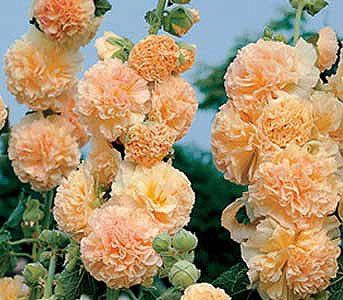

Terry pink
Terry dark red
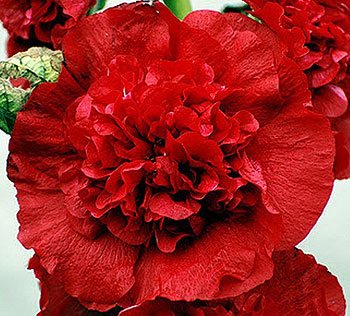

Double Mixed
Mallow planting
Mallows look great in flower beds, ridges and even in mixborders. The best solution would be to plant mallow in threes, at a distance of 3 m on both sides of the garden paths.
A bush of 5 mallows on the lawn will look gorgeous, shrubs with dark green foliage can become the background to them.
Some decorate farm buildings with mallow, in which case they need to be planted thicker.
I know that cut mallows in a vase stand for a long time. If you cut the inflorescences in the budding phase, they will bloom and turn into wonderful flowers.
Related Videos
Mallow is a very common decorative flower with a variety of bright colors and grows along fences or along roadsides. It is not only a beautiful decorative flower, but it also has wonderful healing properties. The plant has many species, divided into three groups: annuals, biennials and perennials.
Perennial mallows are most often planted here, decorating the courtyards of houses. The flower looks good when cut in a vase, as its stems are even and long, decorated with flowers along their entire length. It is quite frost-hardy and winters well outdoors in most regions of Russia. It also tolerates drought well, with roots growing to a depth of three meters.
Growing seedlings
Growing mallow in perennial spring through seedlings is the best way, which has declared its high efficiency. For this procedure, separate containers are selected, filled with soil mixed with sand, followed by planting and care, and only then transplanting into open ground.
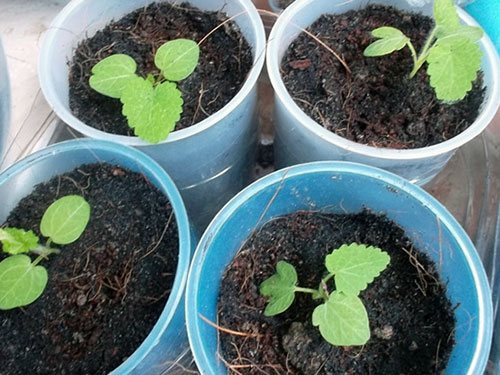

It is worth picking up a separate container for each plant. 2-3 seeds are planted in the hole. After that, it is worth creating a greenhouse effect for the mallow - cover the container with glass or cling film.
Perennial mallow, when planted and nursed in the open field, will give the first shoots in 2-2.5 weeks in spring.If all the seeds were sown in a common container, then when 2-3 leaves appear, it is worth planting the plants in separate pots.
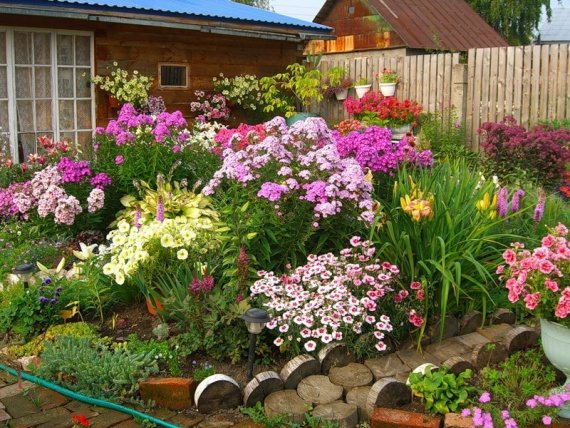

Mallow varieties
It is a herbaceous plant that grows upward and reaches a height of two meters. The leaf plates are larger at the bottom, decreasing towards the top. The leaves are round and soft to the touch. Flowers grow from the axils of the leaves, reaching a diameter of up to 16 cm.
Flowers are double and simple, blooming throughout the summer. The root system of the flower branches strongly and penetrates to a sufficient depth to reach the groundwater in dry season and provide nutrition to the entire plant.
The fruit is located in the place of fading buds and looks like a box filled with seeds. When fully ripe, the capsule opens and the seeds are scattered around the mother bush.
Perennial plant species:
- Musky - has a pleasant aroma, growing to a height of no more than a meter and having small flowers reaching only 5 cm in diameter.
- Wrinkled - growing in fields and forest edges. It is a direct descendant of pink mallow, which is often used by gardeners in the design of their flower beds.
- Forest is very thermophilic, grows under the cover of trees and has small delicate flowers. The height of the plant can be different from 20 cm to one meter. Flowering can last the entire warm season, starting in June.
- Various hybrids were obtained by crossing the main varieties, thanks to which the new varieties have more charming flowers and a high resistance to adverse conditions that arise in nature.
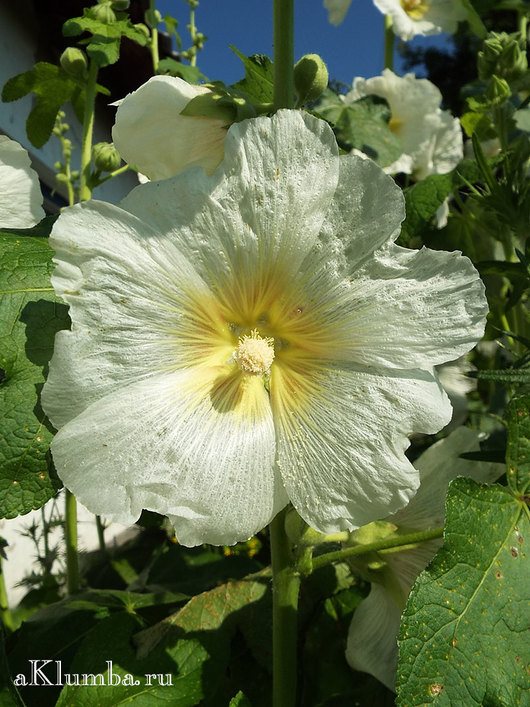

As a result of hybridization, many new varieties have turned out:
- Majorette Mixed - grows up to 80 cm in height and has semi-double flowers, resembling a carnation in appearance.
- Chater'sDouble is a tall, two-meter mallow with double flowers and is a perennial plant. This variety has a wide variety of colors and delicate flowers with a huge amount of lace petals.
- Halo is a variety with simple flowers that have different colors of the flowers themselves, there is a bright spot in the core.
- Nigra - has non-double black-purple flowers
- Cremede Cassis - has semi-double flowers of soft purple hues.
- Peach'n'Dreams - flowers have a peach shade and dense corrugated flowers.
There are many other hybrids that are not so common, but no less attractive.
Annual mallow
Despite the fact that its specific name is annual, in reality this plant lives for two years. It often has striped flower petals and grows up to 120 cm in height. Popular varieties of annual mallow:
- Zebrina, which has large pink flowers with red stripes.
- Black mother-of-pearl - has beautiful violet-velvet flowers of a huge size with black stripes.
Planting dates
It is recommended to plant seedlings of perennial flowers in loose and fertile soil. The place is chosen sunny and, if the variety is high-growing, then it is planted near the fence or immediately a support is installed in the prepared hole, around which the seedlings are planted. Then, as it grows, it will be possible to tie the stems of the plant to the support so that they do not break during bad weather.
In the area where the mallow is planned to be planted, there should be no stagnation of water. If the groundwater is too close to the surface of the earth, then the seedlings are planted on a cushion of rubble and humus.
Plant care
As well as, it is a completely unpretentious plant. In extreme heat, it is watered once a week, weeds are removed and the soil around the plants is loosened. In spring, full mineral fertilizers or compost of 3 kg are applied annually. one square meter. During the period when the buds begin to set, top dressing is carried out with a high content of phosphorus and potassium.
During the summer, you can feed the plant with compost mulch.The main thing is not to overdo it with fertilizing, otherwise you can shorten the flowering time. During the entire flowering period, it is necessary to remove the fading flowers in order to prolong flowering. If the stem has completely bloomed, it is cut to a height of 20 cm.
Seed collection
After flowering, a round seed capsule is formed in place of the bud, containing many small thin-walled seeds, which are densely located near the pedicel. In order for the seeds to ripen well, they need ripening within a month. Just before ripening, the seed heads change their color to yellow and during this period they are cut off and laid out indoors on clean paper for gradual complete drying.
If you are going to grow a plant from your own seeds collected in local flower beds, you must remember that it is well pollinated among themselves, so that when sowing, you can get new varieties that will be no worse than the maternal ones. You just shouldn't be surprised by new color combinations.
This unpretentious flower can be propagated with the help of seeds, which are sown in March for seedlings or immediately in open ground at the end of May. In the first year, crops are well insulated for the winter with leaves or spruce branches.
Seed selection and preparation
Before proceeding with sowing seeds, they are checked for germination, otherwise, if there are dead seeds there, they will simply take up space on the windowsill or under the lamps to illuminate the plant. Having selected the seeds, they are soaked for 12 hours before sowing in order to soften the shell and accelerate seed germination. You may also notice that old seeds germinate much better than just harvested ones.
Seedling
In order to bring the moment of flowering closer, at the beginning of April, seeds are sown immediately in disposable cups or peat tablets. After the seeds have been planted, the temperature in the room should not drop below 20 degrees Celsius. In this case, the first seeds will show their sprouted noses after two weeks.
If the seeds were planted in a common box, then when the first pair of leaves appears, they must be dived and transplanted into separate 100 grams. capacity. Transparent disposable cups work well for this purpose. They will clearly show how the root system of the plant develops.
When the seedlings grow up, and return frosts pass the region, they are planted in open ground. But before planting, the seedlings are hardened for seven days, otherwise, if they are immediately planted in a flower bed, the leaves will lose their turgor and the plant may die on the very first night. Seedling bushes are planted taking into account the overall growth of the plant, so a distance of 50-70 cm is left between the plants.
Growing without seedlings
If you use this method of plant propagation, then the seeds are sown directly into open ground at the end of May. But for this, the beds are prepared in advance by introducing fertilizers into the soil in the form of humus and wood ash. Then, in the bed, shallow holes are made no more than a centimeter deep and the distance between the holes is 70 cm .. You can make the mother bed away from the flower beds and plant there according to the scheme 2 cm between the holes and 10 cm between the rows.
Three selected seeds are placed in each hole and sprinkled with soil, lightly squeezing with your hands to compact the soil, and watered with water. If the natural conditions during the planting period were favorable, then in 15 days the first shoots will appear. When there are three to four leaves on the sprouts, excess sprouts are removed from the holes, which look underdeveloped.
Sowing in open ground in autumn
There is also such a way of propagation of mallow as sowing in open ground in the fall. Such a planting is carried out in September on a site prepared in advance. Dig shallow pits no more than 2 cm, the distance between the holes is 50 cm.And if the planting is done in a nursery, then a distance of about 5 cm is made between the pits.
The sowing site must be sprinkled with peat, which in the cold season will serve as a warm natural pillow for the seeds, which will prevent them from freezing in winter. At the first cold snap, the crops are also covered with dry grass and branches so that the wind does not carry away the dry grass. In spring, the plants will begin to grow as soon as the snow melts, therefore, with return frosts, cover with lutrasil will be required.
Cuttings
This method is used very often when it is necessary to propagate terry mallow. This is done because propagation by seeds does not guarantee the transfer of terry flowers.
Knowing all the methods of breeding a plant, you can choose the way in which it will be easier to propagate it in a particular region in order to have enough seedlings to plant in your own flower beds.
Flowering mallow
Perennial mallow begins to bloom only in the second year of its existence. In the first year, they build up the vegetative mass and the root system. Starting from the second year, the plant blooms annually. Before flowering, a high, up to two meters stem grows, on which flowers appear later.
In one summer, up to 200 flowers can appear on the stem, which, replacing each other, will delight those around them with their flowering all summer. Flowering lasts from June and, depending on the region, may continue until the end of September.
After it finishes its flowering, its stems are cut to ground level and mulched with humus, this will help to cope with winter cold snaps and at the same time will serve as a fertilizer for the soil. The flower should overwinter in central Russia under the shelter of spruce branches or foliage, so as not to freeze in persistent cold weather.
Plant diseases
All diseases come from excess moisture. This flower is sometimes susceptible to powdery mildew, leaf rust, mosaic virus. Therefore, if there were cases of this disease, then you should not plant seedlings of plants in that place.
If any disease is detected, the leaf plates are cut off and burned outside the site so as not to infect the soil. And flower bushes must be disinfected with any antifungal drug.
How to grow mallow in seedlings at home
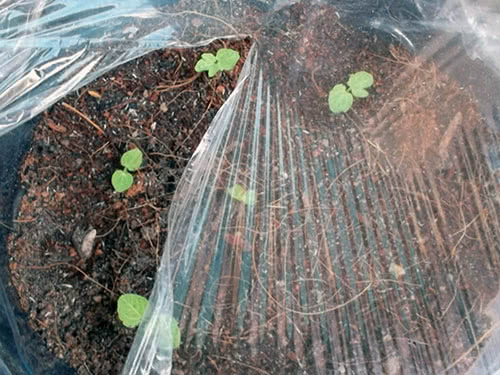

If you can’t wait to admire the flowering mallow already this season, you should use the seedling method of sowing. This can be done in late February - early March, and plant ready-made seedlings after warming up the soil to a permanent place. For the seedling method, peat tablets, pots are suitable. And if you take the cups, then a special soil is prepared for them: in equal shares of sand and humus, as well as two parts of the land from the site.
Mallow does not dive, as the often disturbed root is not able to adapt to a new place.
When the containers are prepared and filled with soil, take two seeds and embed them 2 cm deep into each of them, sprinkle with soil and cover with glass or cellophane film. For seedlings, a temperature regime of at least +20 degrees is required. Next, you should moisten the soil and monitor the growth of mallow, periodically airing the shelter.
Seedlings are planted at the end of May, when the danger of night frosts has finally passed.
Useful properties of mallow
This is a plant that herbalists have known for a long time. With the help of the flower tincture, inflammation in the stomach or intestinal disorders can be cured. Hot baths prepared with wild mallow leaves help to shrink an enlarged spleen.
Also, forest mallow is part of the breast collection. Decoctions of mallow flowers will help to cope with allergic manifestations on human skin and are excellent in healing open wounds and burns.
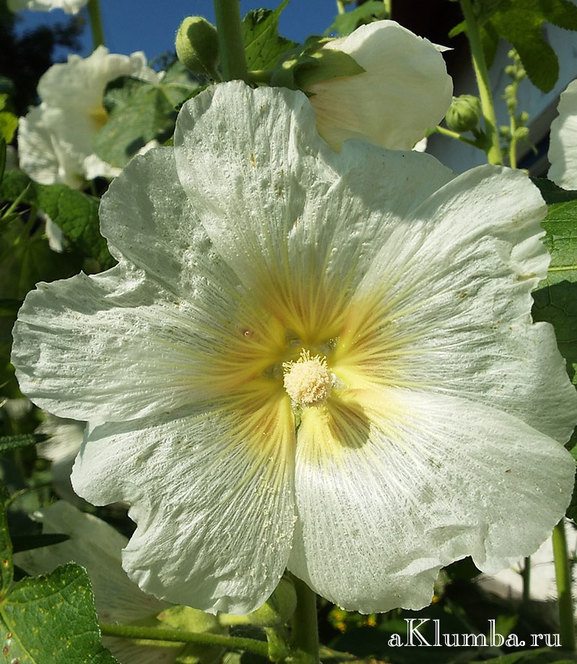

Mallow has the following properties:
- expectorant;
- anti-inflammatory;
- softening;
- fortifying.
In folk medicine, all parts of the plant are used for treatment, and public medicine uses only the vegetative mass of the flower. Dry the assembled parts in the shade, in a well-ventilated area. It must be stored in containers with a signed date of collection.
Although preparations based on mallow are considered not dangerous, they cannot be used without consulting a doctor. Since there is always the likelihood of a person's personal intolerance to this plant.
Today, it is difficult to imagine an amateur florist's front garden without mallow. These tall flowers, decorated with large cups of flowers of various shades, have won strong love and sympathy, and it is these flowers that are usually admired. Once you have planted mallow, you can enjoy the beauty of flowers for almost the entire season. One of the advantages of the plant is considered to be unpretentious care, stunning beauty and some medicinal properties.
When is the best time to plant mallow seeds?
Planting a plant can be carried out in 2 ways - with the help of seeds, with the help of seedlings. Depending on which method has been chosen, certain conditions will be imposed on the cultivation and care of the plant.
Regardless of the landing method, you must first prepare the landing site and the soil itself. Mallow is a perennial plant that does not require replanting. The root system of mallow is progressively developing, and when a plant is transplanted, it is too likely to be damaged.
When choosing a place for planting mallow, you must remember about a number of requirements:
- Good illumination;
- The absence of drafts that can harm the tall stems of the plant - just break them;
- The soil should be loose and nutritious with good drainage.
Experienced growers note that the plant can be demanding on the soil; planting the plant in light loam would be an ideal option.
So when to plant the seeds? It is best to plant seeds in a flower bed at the end of June. It is worth remembering that the flowering of mallow can be expected no earlier than the next year after planting. If it is necessary for the plant to bloom in the same summer, then it is necessary to plant it with seedlings - having previously grown it from seeds starting in winter.
Florist reviews
Yolya
I sowed before winter. Mallow reproduces by self-seeding. Last year I went up, I planted. And now it stands in the buds
Cat N
Yes, two-year-old mallow. But ... Those that we sow in the summer bloom the next year. I noticed that at the base of the flowering specimens, a small bush is formed, which also blooms the next year.
Growing mallow from seeds in a few easy steps
There are about 30 varieties of plants, they will help you in choosing mallow photo
on the seed package.
- It is best to buy seeds in the spring, and plant them in a flower bed at the very beginning of summer.
- The soil for planting must be pre-prepared - it must be loosened and, if necessary, fertilized. If the soil does not meet the requirements - without drainage, it must be diluted with sand.
- There is no need to create holes for sowing seeds, it is enough just to scatter them at a distance of 40 - 70 cm from each other, cover them with a thin layer of earth on top. In this case, the first shoots can be seen in less than a month.
How to care for mallow flowers after seed planting?
The most important advantage of the plant is the fact that mallow is not whimsical and does not require complex care. But still, we must not forget about fertilizing and watering the plant. Watering frequency will directly depend on weather conditions. Sunny weather with occasional rains will require watering no more than once a week. But during drought, the plant needs to be watered more often, but you cannot overdo it - in the "swamp" the plant may die.
It is best to use low concentration calcium phosphate fertilizers as fertilizers.Fertilizer should be applied every few weeks, in addition, it is necessary to periodically loosen the soil near the roots for better aeration of the root system.
Caring for mallow means getting ready for winter. The area where the mallow grows should be covered with fallen leaves or straw.
Mallows are an ideal ornamental plant that will blend perfectly in both the foreground and background of your garden plot. Landscape designers advise planting mallow in the background, in front of low-growing plants, preferably along fences or walls. It will be precisely with them that it will be possible to "cover" nondescript buildings. For a flower arrangement, it is best to use Zebrin mallow
, which will become a real highlight of the flower bed.
The variety of colors of mallow flowers can satisfy even the most sophisticated tastes. Mallow began to be cultivated as an ornamental and medicinal plant a long time ago, more than 3 thousand years ago. And although Asia is considered the homeland of these flowers, today they are common in Europe, Asia and the Americas almost everywhere.
The height of mallow stems can be different: from 80 cm to 250 cm. The size of flowers also varies depending on the variety and region of growth from 5 to 15 cm in diameter. In addition to different colors, mallow flowers can be non-double, semi-double and double.
If you have ever been to the steppe regions, where the temperature in summer reaches +35 - + 40 ° C, you could well observe the intricate bells of mallow flowers right in the middle of a clear field - growing without additional watering and care. This is not surprising at all. Malva loves the open scorching sun and dry summers. Its roots can draw moisture from deep soil layers - more than 3 meters. So this beauty is not afraid of any summer adversity, except for prolonged rains.
Among the whole variety of varieties and species of mallow, there are annual, biennial and perennial flowers. In our region, perennial mallows are more widespread for their unpretentiousness and endurance.
Biennial and perennial mallows tend to bloom only from the second year after sowing the seeds. In the first year, a root rosette of large leaves (rounded or heart-shaped), wrinkled with curly grooves, appears. In the second year, the mallow throws out long tall stems, on which hundreds of flowers are tied - bells - 150-200 pieces. They take up most of the stem and begin to bloom from the bottom up. Flowering begins in June-July and lasts until September.
Fading away, mallow forms seed pods, which are called "kalachiki" in Ukraine. The capsules are composed of numerous small seed fruits gathered around the peduncle. After flowering, the seeds ripen within 3 to 4 weeks. It is necessary to collect them when the boxes turn yellow, and then dry them indoors.
Important! Mallow is a cross-pollinated plant. Collecting flower seeds of various colors from nearby plants, be prepared for the fact that by sowing them in the ground, you will get a riot of colors and completely unexpected hybrids.
Two-year varieties die after flowering, scattering seeds that can germinate the next year under favorable conditions. Perennial flowers continue to bloom from year to year.
Application in garden design
For mallow, its application in garden design is so wide that it can be considered irreplaceable.
It is used:
- along hedges, walls, fences;
- in the background of any flower arrangement;
- for framing entrance groups, gates;
- on mixborders;
- as borders;
- in a bouquet planting;
- in solitary fit;
- for dividing the space into zones, in combination with other tall plants such as sunflowers.
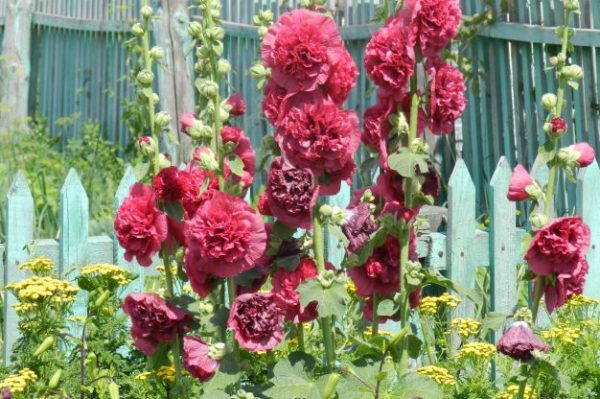

Garden decor
Growing and care features
To better understand where to put our queen, let's clarify her preferences and what she loves.
- Direct sunlight;
- Low groundwater table;
- Permeable and drained soils;
- Light feeding with humus;
- Universal support for long stems so that the wind does not break them;
- High nitrogen content.
What mallow does not tolerate:
- Moisture-saturated soils - waterlogged;
- Strong winds and drafts;
- Shaded areas (may not bloom);
- Transplanting from one place to another (the taproot of the mallow is very deep, it is impossible to dig it out without damaging the plant);
- Too severe frosts (requires cover).
Based on the foregoing, mallow is best planted in dry, open, sunny areas. If you were hoping to plant it in the shade of garden trees, it is better to abandon this venture. Sun starvation is akin to death for our queen.
Very often, mallow is planted near fences and other tall buildings to hide them and at the same time protect the plant from the wind. Also, a high fence will prevent the stems with flowers from breaking off under its strong gusts. But this arrangement is not necessary.
Mallow flowers can be grown in open areas surrounded by lower plants and flowers that will shade the lower stems. A well-developed root system will help them withstand almost any storm.
Sowing mallow seeds is best done in the month of June. According to the scheme 25x25 cm, to a depth of 2 - 3 cm.
Until the end of the season, the flowers will have time to develop and create a good rosette. After the emergence of shoots, it is imperative to weed. In September, plants can be transplanted to a permanent place. You should get low bushes. Before frost they will get stronger. Before winter, it is advisable to cover them with branches or other dead wood so that they do not freeze.
In the second year, the root system will develop, and the plant will throw out flower stalks. Perennial varieties will delight you with their flowering for many years. If there is a desire to collect seeds for the future, it is described just above how to do this.
In very dry weather, the mallow can be watered, but not waterlogged. If you wish, you can feed it with humus once a season or just pour well-rotted compost or manure as mulch. But this is optional. Mallow is undemanding.
Choosing a landing site
One of the main requirements to consider before planting mallow is the correct site selection. A place for the plant must be allocated with the expectation that it will not transplant. The fact is that the stock-rose very painfully tolerates the transplant and often does not take root at all after such a movement. This is explained by the presence of powerful roots, which are easily damaged when excavated.
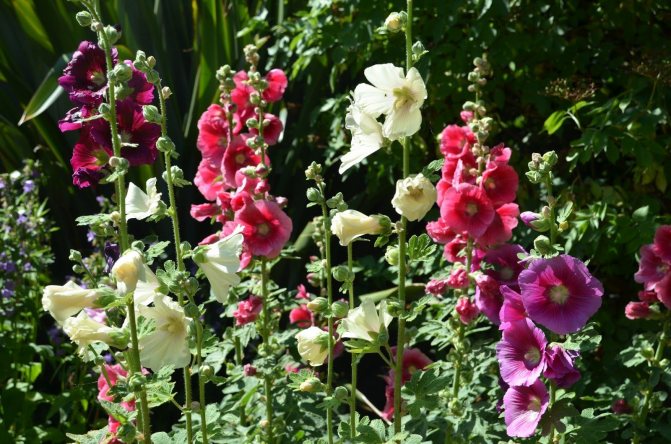

The site should be well lit and located in the sun. With a lack of sunlight, the mallow bloom will not be as bright and plentiful as it could be. At the same time, the site should not be completely open, since winds and drafts negatively affect the stem-rose. If you neglect this rule, then under the influence of the winds the plant will look tortured, and with strong gusts it can completely break.
What should be the soil
Loam is considered the most suitable soil for planting mallow. The soil does not have to be nutritious, since the flower, with periodic fertilization, grows even on the poorest soils.
The main condition that the earth must meet is good drainage, since stagnant moisture negatively affects the state of the root system.
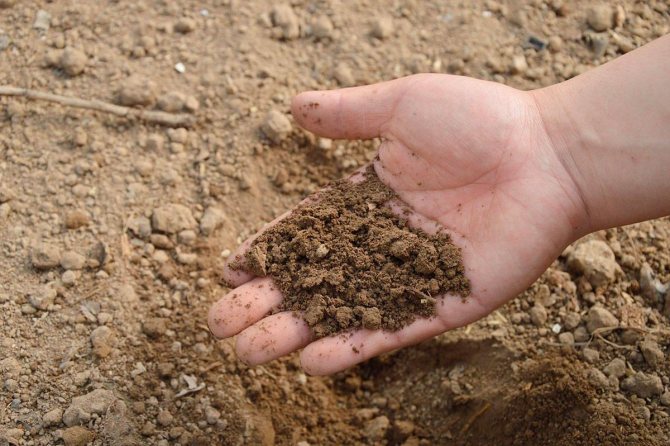

The ground should not be too clayey. Otherwise, it becomes heavy, and mallow prefers light soil. The plant needs neutral acidity, but even when slightly alkaline or acidic, the flower will still grow.
Soil preparation
Regardless of the chosen method of planting mallow, you need to properly prepare the area on which it will grow. The allotted place should be dug deeply, and then manure or compost should be added.In order for the land to be well-drained, river sand is added to it, which in the soil composition should occupy a fourth part.
Diseases and the fight against them
All diseases that mallow can hurt are associated with only one misfortune - a lot of moisture. Either the soil is too wet or the rain is too frequent.
The most common diseases of these flowers are leaf rust, powdery mildew and spot, stem cancer, mosaic virus and others.
If signs of disease are detected, the affected leaves must be completely removed and the flower treated with Mikosan-V, Fito-Doctor, Trichodermin or other antifungal preparations. But most importantly, remember - the cause of the onset of the disease is excess moisture. Without eliminating the cause, the fight against the disease will be unsuccessful.
To be honest, mallow is a “planted and forgotten” type of flowers. Starting from the second year of the growing season, it does not require absolutely any attention to itself, it does not even need much weeding - weeds are not rivals to it, since the roots reach several meters in depth. It turns out - "beauty without labor."

